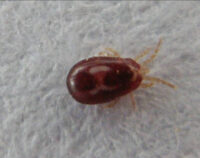
QUICK TIPS: To help control bird mites, do a nest change, empty out nestboxes after fledging, and try low-level pyrethrin spray for caged birds.
Tiny parasites frequently infest bird nests. Mites (also called bird lice) are common in Tree Swallows (TRES) and Purple Martin nests. They are less common in bluebird nests. If a nest is infested with mites, here are some options: A single Purple Martin nest might house as many as 1,000 fleas, 6,000 mites and 100 blow fly larvae, all of which are feasting on baby bird blood. (Williams 2020) Fortunately, otherwise healthy nestlings can withstand most onslaughts, although they could predispose them to other problems. Sometimes infestations are so bad that purple martin nestlings become “jumpers,” leaping to their death to escape the pests. Note that mites are species-specific, and the kind found on birds does not live on human blood.
- Replace the nest with a clean one. See how to do a nest change.
- Clean out the nestbox after babies fledge, or at a minimum at the end of nesting season. See Cleaning.
- Pyrethrin-based bird sprays: Low-level Pyrethrins (0.03 – 0.1%) are “natural” pesticides produced by members of the chrysanthemum family. Commercially available sprays (e.g., Scalex) are available for caged pet birds, and are supposedly safe. It’s probably a good idea to do a nest change at the same time.
- Provide TRES with clean feathers for nesting can prevent mite infestations. This is probably unrealistic for large trails.
- Diatomaceous Earth (DE): is a “natural” abrasive that purple martin landlords used to sprinkle underneath a nest. Only food grade (not swimming pool DE) is used. It can be put in a plastic bottle with a very small opening. If there are nestlings that are too young to move, place your hand or a paper towel over them during dusting. When fleshy insects/larvae pass over the dust, the sharp particles cause them to dry up and die (Wet DE does not work.) Unfortunately, it can cause serious lung issues if inhaled. If nestlings are flapping their wings around in the nest, it can become airborne, so many purple martin landlords have stopped using it.
- Sevin 5% dust: available in various strengths or concentrations it is important to only use the 5% available in the gardening section. Used for poultry and also dog and cat parasite control, Sevin 5% is aneffective pesticide. It must be used in minute amounts. 1/4 teaspoon (NOT tablespoon) applied in the nest but not directly on the young is all that is required. Those who oppose Sevin cite the fact that domesticated chickens are NOT purple martins and one study showed harmful, though not lethal, effects in non-target wildlife.
- OTHER POSSIBILITIES of unknown effectivenes: Some people use tobacco leaves, eucalyptus leaves, rosemary sprigs, and cedar shavings.
DO NOT Use Powder Sulfur – it can irritate a nestlings eyes, skin and lungs.
Sources and More Information:
- Williams, H. M., K. Dittmar, and S. Smith Pagano. 2020. A parasite reduction conservation intervention does not improve fledging success or most condition metrics for Purple Martins. The Condor: Ornithological Applications 122(4): 1–14. https://doi.org/10.1093/condor/duaa051
- How do to a nest change
- Cleaning out nestboxes
- Blow flies
- Gnats, Black flies, etc.
- Fire Ants
- Ticks and tickbourne illnesses
I wanted to know the name of every stone and flower and insect and bird and beast. I wanted to know where it got its color, where it got its life – but there was no one to tell me. – George Washington Carver
